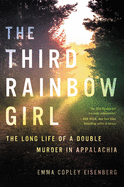
The Third Rainbow Girl is a fascinating hybrid work of true crime and memoir loosely centered on a 1980 double murder in Pocahontas County, W.Va., and the lengthy aftermath. The victims were two young women hitchhiking to a nearby peace festival called the Rainbow Gathering; they were found dead of gunshot wounds in an isolated clearing, sparking intense media speculation and absorbing the local community for decades. The book details a circuitous and flawed investigation that, years later, resulted in the arrest and charging of nine local men with crimes connected to the killings. Emma Copley Eisenberg weaves the story of the Rainbow Murders and the subsequent hunt for justice with her own experiences in Pocahontas County and the historical context of West Virginia, a place she characterizes as deeply misunderstood. In following the twists and turns of the case, Eisenberg paints an affectionate portrait of Appalachia that complicates and contradicts stereotypes about the region.
The police investigation was made difficult by a dearth of evidence and an abundance of rumors. The only thing anybody seemed to agree on was that the murderer must have been a local because of the remoteness of the clearing where the women were found. This was in addition to a belief that the Rainbow Gathering had invited a culture clash between locals and attendees. However, Eisenberg shows this to be the first of many oversimplifications that dogged the case. In reality, West Virginia had absorbed a tremendous amount of "back to the landers" in the 1970s--people fleeing the cities for more rural parts of the country. West Virginia was much more prepared for an influx of hippie types than outsiders would expect. Moreover, Eisenberg provides background on West Virginia's history that challenges common perceptions of the area as a conservative backwater, pointing to the state's separation from Virginia during the Civil War, for example. Eisenberg writes about a "twoness or bothness" that she observed in West Virginia:
"There were lifted Ford 150 trucks with signs that said 'Rebel Pride,' and 'You can pry my gun out of my cold dead hands,' and 'Real women drive trucks.' But in equal or greater numbers there were Subarus and Toyota Tacomas that said 'Birthplace of Rivers,' or bore stickers for the Human Rights Commission or that said FRACKING in an oval with a line drawn through it."
Eisenberg makes it clear very early on that "the murders were a trauma experienced on a community scale." The brutality of the crime was a shock to the small community, but the investigation left its own wounds. Eisenberg's recap of the long investigation is where the book most resembles true-crime phenomena like Serial or The Staircase. There are surprising developments, as when the police discover a third "Rainbow girl," Elizabeth, who had planned to take the trip with the victims, Vicki and Nancy. Then there's the case of Jacob Beard, who becomes a suspect after placing a strange call to Vicki's family. Eisenberg is very aware of the fact that she is entering uncertain territory--this is an investigation that faced accusations of police abuse and coaching of false confessions. Beliefs about who is innocent and who is guilty are fervently held and disputed--introducing sharp divides in a small, close-knit community. Eisenberg resists drawing definite conclusions in the midst of all this confusion, preferring to dwell on the destructive power of accusations and rumors, the influence of confirmation bias and the way messy realities are shaped into tidy narratives.
The Third Rainbow Girl is also part memoir, with Eisenberg recalling her time in Pocahontas County working for a nonprofit organization for teenage girls called Mountain Views. Eisenberg fell in love with West Virginia while she learned hard facts: "Thirty-two percent of West Virginia women and girls smoke (the highest rate in the nation), and they report much more stress, anxiety, and depression in their lives than women nationally." As a New York City kid, Eisenberg had a lot to learn about living in Pocahontas County, seeming to thrill in the self-reliance it inspired: "I learned... most problems in the physical world could be solved if you simply got down on your knees to look and believed in your own abilities to find a solution."
Eisenberg also fell in with a group of largely young men who liked to drink and party well into the night, sometimes going for multiple days. Without romanticizing anything, Eisenberg is successful at showing the extremely tight bonds among the men, and they form a miniature community that she feels grateful to be included in--grateful enough that she can overlook a few uncomfortable moments, and even finds herself in a relationship despite her ambivalent feelings. Eisenberg doesn't make any grand claims connecting her experience to the Rainbow Murders or the subsequent investigation, preferring to develop a complex portrait of the community that includes both its challenges and its joys. Her experiences usefully contextualize the true-crime story at the heart of the book, helping the reader understand the unique local conditions that allowed the investigation to unearth so much darkness, fracture the community and do lasting damage to seemingly innocent people. --Hank Stephenson

